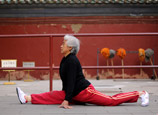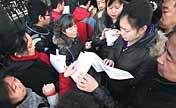
BEIJING, March 12 (Xinhua) -- "Made in China" goods have long-dominated the global market, but rising costs are weakening China's price edge and strengthening the country's resolve to come up with "new edges," analysts say.
Calls to create new competitive edges in technologies, brands, quality and service have appeared in a government work report delivered by Premier Wen Jiabao to the ongoing annual session of the National People's Congress, China's top legislature.
The government report said China should raise the quality of, and returns on, foreign trade, rather than just increase the foreign trade volume. Instead of relying solely on cost and price advantages, it should also raise its overall competitive advantages.
Analysts say all of this signals a shift in China's export policy, in which it hopes to export more high-quality goods and those with a higher profit ratio.
The shift is also a timely response to dramatic changes in both domestic and overseas markets, which used to serve China's export industry and its overall economy well.
According to data released Friday, China's exports jumped 20.6 percent year on year in February, well beyond analysts' expectations for single-digit growth as companies shut down for the Spring Festival holiday, which fell in February this year.
Commerce Minister Chen Deming also announced last week that the country's export volume in 2012 is expected to constitute 11 percent of the world's total.
However, the increased total export volume and an apparent rebound trend in February are not representative of the entire situation.
The annual East China Fair, a major barometer of China's trade situation, closed in Shanghai a week ago. Numbers of overseas customers and deals dropped 5.3 percent and 9.9 percent, respectively, year on year.
Wang Tingge, president of a trading company in east China's Zhejiang Province, attributed trade difficulties to weak overseas demand and a decline in the competitiveness of Chinese goods in terms of price. He said the monthly income of a typical textile worker in Zhejiang was around 600 U.S. dollars, four times that of a Cambodian worker.
Cai Hongbin, director of the Guanghua School of Management, Peking University, said China's exports had grown at an average annual rate of over 20 percent for the past decade, reflecting China's industrial competitiveness, "but this competitiveness is fading fast."
 |
















 Year's first rainfall for Beijing
Year's first rainfall for Beijing


![]()
